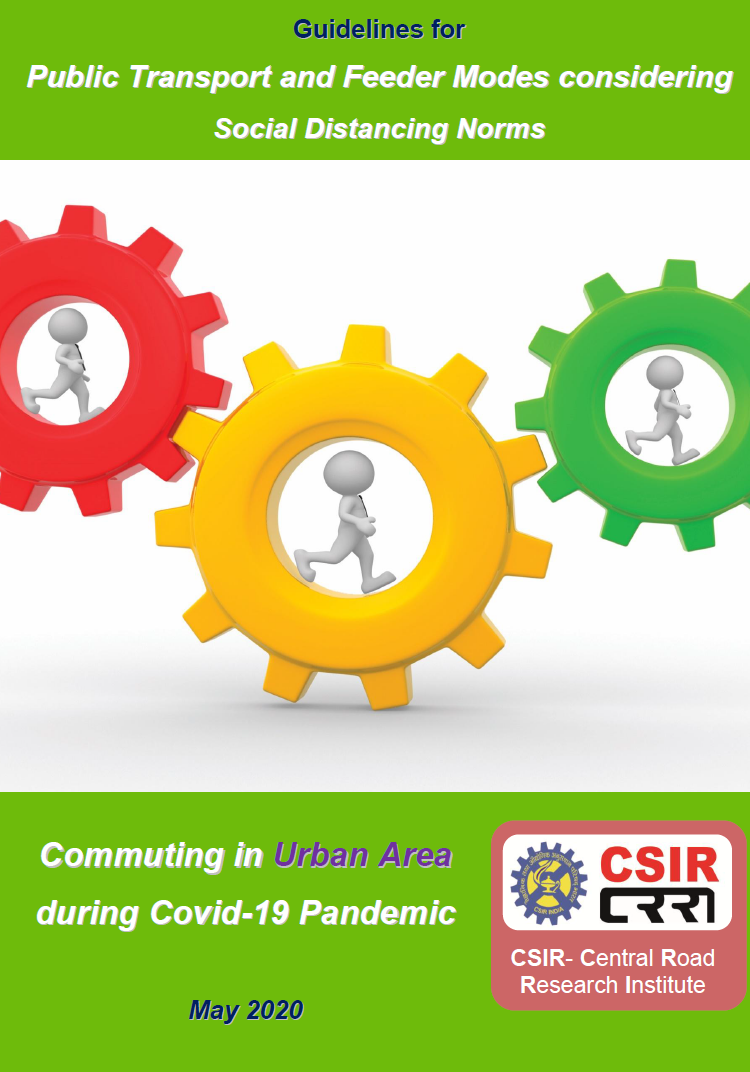Ministry of Science & Technology
Getting on to a New Normal Lane in Public Transport
प्रविष्टि तिथि:
07 MAY 2020 4:49PM by PIB Mumbai
Mumbai / New Delhi, May 7, 2020
The lockdown enforced by the Govt of India to control the spread of COVID19 Pandemic has been extended till May 17, 2020. While it is essential to relax the lockdown in order to facilitate easy flow of goods, services and the economy, it is equally important to ensure that the deadly virus is prevented from spreading. Now this puts forth a challenge in front of the government as to how to control the spread, when lakhs of commuters are expected to reach for public transport system once the lockdown is relaxed.
Against this backdrop, the Centre for Road Research Institute (CRRI), a laboratory under Council of Scientific and Industrial Research, has come up with an action plan to enable safe public transportation. In its new Guidelines for Public Transport and Feeder Modes considering Social Distancing Norms, CRRI has drafted safety measures for every mode of public transport.

As per CRRI’s report, currently there are around 10 cities with operational metro network - a total network of more than 700 kilometres and about 525 metro stations. More than 1.6 million buses are registered in India, and the public bus sector operates 1,70,000 buses carrying roughly 7 crore people per day.
In order to control the spread after the lockdown CRRI suggests a combination of two different approaches.
Approach A: Redesigning facilities enabling social distancing
- Painted Markings for social distancing exhorting people to maintain the required distance around bus stop areas, on footpaths, etc.
- Increased stopping time / dwell time for commuter boarding / alighting for bus and metro.
- Separate gates for boarding and alighting while travelling by bus and metro.
- Limit number of commuters inside bus / metro coach.
- Separate lane for buses to improve capacity of bus service.
Approach B: Reducing Demand and Capacity Enhancement
- To reduce demand for public transport by encouraging short trips by non-motorised modes (bicycle) and intermediate public transport modes (cycle rickshaws, autos, etc.)
- Shops / markets/ offices having public dealings to be opened for longer duration to avoid larger gathering and crowds.
- Encourage advanced booking for bus / metro by up to 80%.
- Staggered timings for office-goers
In addition, CRRI has also suggested different measures to be taken to ensure social distancing on footpaths, metro stations, bus stops and its surrounding areas, e-rickshaws, autos and taxis including steps to be followed for the safety of bus operators.
1. Footpath
By splitting Zebra Crossing into two parts for each direction or by marking two separate zebra crossings. This can control the spread between pedestrians by enabling social distancing at intersections.
2. Metro
a) By displaying information about vacant seats in a particular coach. The number of seats vacant within each coach should be dynamically displayed at the respective stations/ coaches on the display boards.
b) Commuters should avoid touching the scanning machine using tokens/cards, instead they should keep it at least 10 mm above the scanning point.
3. Bus
While traveling by bus, only one person per seat should be allowed. Also, the commuters should sit diagonally opposite their co-commuters.
4. Bus Operators
By limiting seating capacity in the bus (50 % of actual capacity). Also, by limiting access to driver cockpit area.
5. E-Rickshaws, Autos, Taxis
Drivers are suggested to use plastic sheet for physical separation between driver and commuter as well as within commuters in case of auto/ e-rickshaw/taxi.
Short-length trips by intermediate public transport modes (rickshaws, autos, etc.) to be encouraged as well as a dedicated path / lane should be allotted for faster movement of such vehicles.
Paving the Way to a New Normal
The CRRI guidelines can be read here. Releasing the guidelines, the Union Minister for Science & Technology and Health & Family Welfare, Dr. Harsh Vardhan, said, “Post COVID-19, a new normal will develop in the society, setting new standards to live in a better way, in a scientific way which will eventually become Good Health Norms”.
The Union Minister for Road Transport & Highways, Shri Nitin Gadkari, while addressing the members of Bus and Car Operators Confederation of India through video conferencing mode, has said that opening of transport and highways will go a long way in instilling confidence among the public. He has stated that public transport may open soon with some guidelines. He has cautioned about maintaining social distance and adopting all safety measures like hand washing, use of sanitizers, face masks, etc. while operating buses and cars.
As the Ministers said, the guidelines issued by CRRI and citizen’s cooperation in executing these will pave the way towards a safer environment in the fight against COVID-19 and restoration of normalcy post lockdown.
***
DL
Follow us on social media:  @PIBMumbai
@PIBMumbai  /PIBMumbai
/PIBMumbai  /pibmumbai
/pibmumbai  pibmumbai[at]gmail[dot]com
pibmumbai[at]gmail[dot]com
(रिलीज़ आईडी: 1621810)
आगंतुक पटल : 1108
इस विज्ञप्ति को इन भाषाओं में पढ़ें:
Marathi